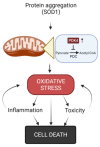Muscle Involvement in Amyotrophic Lateral Sclerosis: Understanding the Pathogenesis and Advancing Therapeutics
- PMID: 38002264
- PMCID: PMC10669302
- DOI: 10.3390/biom13111582
Muscle Involvement in Amyotrophic Lateral Sclerosis: Understanding the Pathogenesis and Advancing Therapeutics
Abstract
Amyotrophic lateral sclerosis (ALS) is a fatal condition characterized by the selective loss of motor neurons in the motor cortex, brainstem, and spinal cord. Muscle involvement, muscle atrophy, and subsequent paralysis are among the main features of this disease, which is defined as a neuromuscular disorder. ALS is a persistently progressive disease, and as motor neurons continue to degenerate, individuals with ALS experience a gradual decline in their ability to perform daily activities. Ultimately, muscle function loss may result in paralysis, presenting significant challenges in mobility, communication, and self-care. While the majority of ALS research has traditionally focused on pathogenic pathways in the central nervous system, there has been a great interest in muscle research. These studies were carried out on patients and animal models in order to better understand the molecular mechanisms involved and to develop therapies aimed at improving muscle function. This review summarizes the features of ALS and discusses the role of muscle, as well as examines recent studies in the development of treatments.
Keywords: amyotrophic lateral sclerosis; muscle atrophy; skeletal muscle.
Conflict of interest statement
The author declares no conflict of interest.
Figures



References
Publication types
MeSH terms
LinkOut - more resources
Full Text Sources
Medical
Miscellaneous

